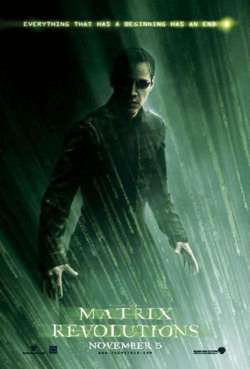Dan Owen reviews

- Cert:

- Running time: 129 minutes
- Year: 2003
- Released Worldwide: 5th August 2003, 2pm GMT
- Widescreen Ratio: 2.35:1
- Sound: DTS, Dolby Digital, SDDS
Director:
- Larry Wachowski & Andy Wachowski
(Bound, The Matrix, The Matrix Reloaded, The Matrix Revolutions)
Producers:
- Bruce Berman, Grant Hill, Joel Silver, Andy Wachowski & Larry Wachowski
Screenplay:
- Larry Wachowski & Andy Wachowski
(Assassins, Bound, The Matrix, The Matrix Reloaded, The Matrix Revolutions)
Cinematography:
- Bill Pope
Music:
- Don Davis
Cast:
- Neo/Thomas Anderson: Keanu Reeves
Trinity: Carrie-Anne Moss
Morpheus: Laurence Fishburne
Agent Smith: Hugo Weaving
Niobe: Jada Pinkett Smith
The Oracle: Mary Alice
Bane: Ian Bliss
Link: Harold Perrineau
Lock: Harry J. Lennix
Persephone: Monica Bellucci
Merovingian: Lambert Wilson
Seraph: Sing Ngai
Zee: Nona M. Gaye
Kid: Clayton Watson
Sati: Tanveer Atwal
Trainman: Bruce Spence
For every beginning there is an end.
That beginning came in 1999, whenThe Matrixbecame a surprise blockbuster hit in a summer many thoughtwould be dominated byStar Wars Episode I.Now, nearly five years later, the Matrix trilogy is complete.
While many criticized the first sequel, The Matrix Reloaded for itschaotic plotting and reliance on spectacle, others praised its deepeningof the franchise’s mythology and disregard of blockbuster convention.Can you name another action movie that chooses to climax on aconversation with a bearded man?(DVDfever Dom adds: “The Ten Commandments?… I’ll get me coat.”)
But it’s true that Reloaded, while an exciting technical marvel, didn’tdeliver the same emotional impact of its more cerebral predecessor. Sohas The Matrix Revolutions delivered the goods?
Revolutions continues exactly where Reloaded climaxed – with Neocomatose in a limbo state, the human city of Zion facing imminentdestruction by machines and with rogue Agent Smith busily cloninghimself throughout The Matrix’s population.
Unlike the agenda-setting Reloaded, Revolutions benefits greatly from anincreased sense of urgency. The pacing is much brisker, despite theoccasional sojourn into philosophical musings, and the characters allhave something far more tangible to threaten them. A spark of energythat was lacking in Reloaded makes a welcome return, and characters thatpreviously seemed bland and unremarkable become more real – particularlythe “annoying” Kid character introduced in Reloaded.
Of course, the special-effects are extraordinarily effective, butdeservedly not the focus. Reloaded’s dense plotting meant it had to bealleviated by two somewhat pointless sequences (the burly brawl fightwith a hundred Smiths and the freeway car chase), but Revolutions’ ownset-pieces are integral to the plot and therefore far more enjoyable.
The pivotal action sequence between the humans of Zion and the machinesis an immensely satisfying and exciting moment of contemporary actioncinema. Likewise, the climactic battle between Neo and Agent Smith in arain-soaked malfunctioning Matrix is supreme entertainment and wonderfulto behold.
Sadly, the acting remains stuck in a venerable state between remote andintellectual. Keanu Reeves and Carrie-Anne Moss continue to stare ateach other with doe-eyes, while Laurence Fishburne generally actsquietly confident.
As always, only Hugo Weaving as the mischievous Agent Smith has anytangible fun with his role, bringing great sophistication, malice andhumour to his role. Ironically, he’s by far the most human character.
Sadly, Lambert Wilson and Monica Bellucci‘s roles as enigmatic Matrixprograms are criminally small. In fact, Bellucci barely speaks andWilson’s role as the dastardly Merovingian becomes a minor subplot thatdead-ends far too abruptly. One can’t help thinking an opportunity withthese characters was missed, particularly when remembering theirimportant roles in Reloaded.
A special mention must go to Mary Alice, who replaces the late GloriaFoster in the role of the all-seeing Oracle. Changing an actress duringa trilogy is always very risky, but thankfully Alice brings a great dealof grace to the role and should be commended for doing a great job underdifficult circumstances.
But in the world of The Matrix, premise is king. While the uniqueness ofThe Matrix will never be bettered, Reloaded managed to throw someintellectual curve-balls into the equation, and Revolutions successfullymanages to bring them all to a fitting conclusion.
Rather remarkably, the finale to Revolutions is neat, tidy and generallyvery logical. Of course, there are still threads left dangling and a fewleaps of logic are required from the audience… but the WachowskiBrothers should be congratulated by avoiding the one pitfall that couldhave shipwrecked their trilogy’s legacy: a duff ending.
The Matrix remains the classic piece of filmmaking – a magnificent mixof styles and ideas that shook the movie world on the eve of themillennium. The Matrix Reloaded was an enjoyable bridge between thetrilogy, packed with some crazy visuals and philosophical layering, andThe Matrix Revolutions is the emotional pay-off for the WachowskiBrothers 6-hour epic.
Imaginative and stylish, the films are almost a sci-fi opera withspecial-effects replacing the songs. The Matrix Trilogy may have itsdetractors (name me a film that doesn’t!) but there’s no denying itsimpact on the social consciousness and the sheer joy in watching thetrilogy takes it final bow.
I’ll certainly miss entering The Matrix.
PERFORMANCES
PLOT
SPECIAL FX
MUSIC/SOUND


















 OVERALL
OVERALL



Reviewer of movies, videogames and music since 1994. Aortic valve operation survivor from the same year. Running DVDfever.co.uk since 2000. Nobel Peace Prize winner 2021.
